This page contains the detailed and Q/A for AQA GCSE Physics Electricity for revision and understanding Electricity.
Electrical charges and fields
P 4.1 : Page No. 51
(1)a
(i)When two insulators are rubbed there is a transfer of electrons from one material to another. Rubbing a polythene rod with a dry cloth transfers electrons to the surface atoms of the rod from the cloth. So the polythene rod becomes negatively charged.
(ii)Rubbing a Perspex rod with a dry cloth transfers electrons from the surface atoms of the rod on to the cloth. So the Perspex rod becomes positively charged. Its positive charge is equal to the negative charge of the dry cloth.
(b) On rubbing with a dry cloth electrons transferred from glass rod to a dry cloth, so the glass is charged positive and a dry cloth acquired negative charge. So glass rod has lost the electrons to a dry cloth.
(2)
(a) Then rod A attract rod B as they both will be positively charged.
(b) Then rod A repel rod B as they both will be negatively charged.
(3)
(a) Then attraction takes place. Because unlike charges attract each other.
(b) Then attraction takes place. Because unlike charges attract each other.
(c) Repulsion takes place. Because Like charges repel and they both are negatively charged.
(4)
(a) That both the rods contain same charge and like charges repel each other.
(b) If rod R is attract by rod X and Y, then rod X and Y are positively charged because unlike charges attract each other. If rod R is repel by both rod X and Y, then rod X and Y are negatively charged because like charges repel each other.
(5)
(a) When we walk on the nylon carpet we get charged due to friction. The extra electrons build up on our body. When we touch the metal then the gained electrons jump to the metal radiator as it is a conductor giving us the current.
(b) When we sit in the car we get charged due to friction between our clothes and the car seat. When we come out of the car and touch the metal body of the car, the charge travels to the metal car giving us a shock.
P 4.2 Current and charge
1 1 Cell.
2 Open Switch.
3 Bulb.
4 Fuse.
2(a)
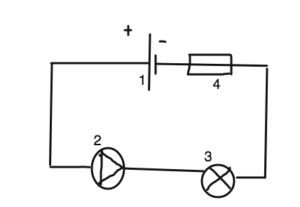
(b)A variable resistor.
(c) The charge that passes through the lamp = 0.25*60 = 15C.
(3)
(a)An Ammeter is used to measure the current in the circuit. An ammeter is always connected in series with the circuit.
(b) A variable resistor is used to vary the current in the circuit.
4 (a)
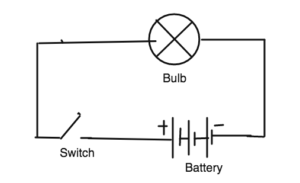
(b) When the switch is closed the electrons from the battery will move from
positive terminal towards the negative. When they reach the bulb, the will loose energy due to resistance. The electrical energy will be transferred to the bulb which will convert it into light energy and light the lamps.
P4.3
(a) V = IR
So R = 4/0.5 = 8ohm.
(b) V = IR
R = 0.5/0.05 = 10 ohm.
- W = 12/2 =6ohm resistance.
X = 80V potential difference.
Y = 6/3 = 2A current.
3 R = 12/0.015 = 800ohm.
b I Charge passing through the torch bulb = 0.015*1200 = 18C
II E = Q*V = 18*12 = 216J.
4 a Resistance of the wire = 1/0.1 = 10ohm.
4 b(i) I = 1.6/10 = 0.16amperes.
ii p.d. = 0.42*10 = 420V.
P4.4 Page No. 57
1 a i Thermistor :- Resistance of the thermistor increases as the temperature increases.
ii Diode :- Resistance depends on the way it is connected in the circuit.
iii The resistance increases as the current increases. So, the resistance of a filament lamp increases as the filament temperature increases.
b I R = 1/0.1 = 10 ohm
ii R = 2/0.2 = 10ohm.
- A We know that V = IR
So Resistance at this temperature = 9/0.6 = 15ohm.
b A thermistor is a temperature-dependent resistor, and its resistance decreases if its temperature increases (and increases if the temperature decreases).So if we increase the thermistor temperature then its resistance decreases and more current can flow through so there will be an increase in the reading of the ammeter.
3 The resistance of a light-dependent resistor (LDR) decreases if the light intensity increases and increases if the light intensity decreases if we covered a LDR its resistance increases so less amount of current flow through it and ammeter reading will fal
4 (a) Initially the current is zero as we increase the potential difference and after some time on increasing further potential difference suddenly increase in a current takes place. In the reverse direction , the current is virtually zero. The current increases after the voltage exceeds a certain threshold.
(b) In the forward direction, the line curves towards they-axis. So the current is not directly proportional to the potential difference. The resistance changes as the current changes. A diode is a non-ohmic conductor. In the reverse direction, the current is virtually zero. So the diode’s resistance in the reverse direction is a lot higher than its resistance is in the forward direction.
P4.5 Page No. 59
1 a The potential difference across the other bulb = 1.2-0.8 = 0.4V.
b I = 1/5 = 0.2A.
V = 1.5-1.0 = 0.5V.
2 a)
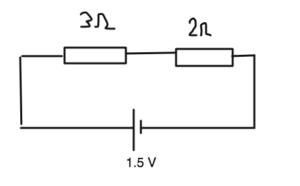
b R = 3+2 = 5ohm.
ii I = 1.5/5 = 0.3A.
c As we know that V = IR
1.5 = 0.25(2+X) = 0.5+0.25X
Therefore 0.25X = 1.5-0.5 =1.0
And X = 1/0.25 = 4 ohm.
3 i R = 2+10 = 12ohm.
ii Total potential difference = 1.5+1.5 = 3V.
b I = 3/12 = 0.25A.
c For 2 ohm resistor p.d. = 0.25*2 = 0.5V.
For 10 ohm resistor p.d. = 0.25*10 = 2.5V.
d i Then total resistance R = 3+2+10 = 15ohm.
ii I = 3/15 = 0.2A.
iii For 2 ohm resistor p.d. = 0.2*2 = 0.4V.
For 10 ohm resistor p.d. = 0.2*10 = 2V.
For 3 ohm resistor p.d. = 0.2*3 = 0.6V.
4 Adding more resistors in series increases the total resistance of the circuit. This is because the total potential difference is shared between more resistors, and as a result the potential difference across each of them is less than before. The current through the resistors is therefore less than before, and as the total potential difference is unchanged, the total resistance is therefore greater.
P4.6 Page No. 61
1a A3 = 0.40-0.10 = 0.30A
b The bigger the resistance of the component, the smaller the current through it. The component that has the biggest resistance passes the smallest current. So the 3ohm resistor passes the most current
c 1/R = 1/1+1/2+1/6 = 10/6
So R = 6/10 = 0.6ohm.
2 a i As we know that V = IR
I = 6/12 = 0.50A.
ii I = 6/24 = 0.25A.
c 1/R = 1/12+1/24 = 3/24
So R = 24/3 = 8ohm.
I = 6/8 = 0.75A.
3 a i I1 = 6/2 = 3A.
I2 = 6/3 = 2A.
I3 = 6/6 = 1A
i 1/R = 1/2+1/3+1/6 = 1
R = 1ohm.
I = 6/1 = 6A.
b 1/R = 1/2+1/3+1/4 = 13/12
R = 12/13ohm.
I = 6*13/12 = 6.5A
4 Adding more resistors in parallel decreases the total resistance. This is because the total potential difference is the same across each resistor.
1/R = 1/2+1/3+1/6 = 1
Equivalent resistance R = 1ohm
Summary questions: Page No. 62
(1)
b resistor
c thermistor
d diode
3 a
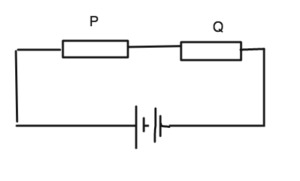
b In the circuit in part a, resistor P has a resistance of4.0 {l, resistor Q has a resistance of 6.0fl, and each cell has a potential difference of 1.5V. Calculate:
i 2 × 1.5 V =3.0 V (V1 + V2)
ii 4.0 Ω + 6.0 Ω = 10 Ω (R1 + R2)
iii 3.0 V/10 Ω (Vtotal/R total)
= 0.30 A
iv VP = (0.30 A × 4.0 Ω =) 1.2 V
VQ = (0.30A × 6.0 Ω =) 1.8 V
4 a
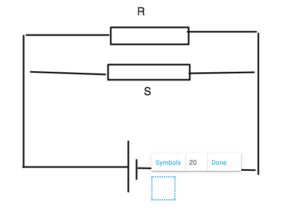
i 2.0 V/8.0 Ω ( V/R)
= 0.25 A
ii 2.0 V/4.0 Ω (V/R)
= 0.50 A
Iii (0.50 A + 0.25 A =) 0.75 A Total current is the sum of the current through each resistor.
5 a i 0.010 A × 200 Ω = 2.0 V V= IX R
ii 3.0 V – 2.0 V = 1.0 V Total Voltage – Voltage Across 200 ohms
iii 1.0 V/0.010 A = 100 Ω ( Resistance = V/I)
b i The ammeter reading will decreases as the resistance of the LDR will increase so the current reading will decrease.
ii Voltage across the LDR = IR
p.d. across LDR = V – (I × R)
so RLDR = V – (I × R) ÷ I
6
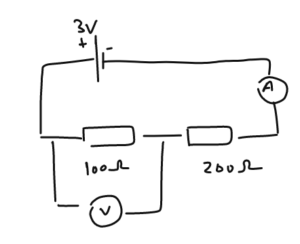
b i(100 Ω + 200 Ω) = 300 Ω Total Resistance = R1 + R2
ii 3.0 V/300 Ω (Total Current = Total Voltage/Total Resistance )
= 0.01 A
iii 0.01 A × 100 Ω
= 1.0 V ( Voltage = Current X Resistance)
iv V across 100 Ω = 1.0 V
V across 200 Ω = 3.0 V – 1.0 V = 2.0 V
7 a i The potential difference gets divided between the two devices. So if one has a potential difference of 0.6 V the other will be 2.4 V so that the total is 3V.
3.0 V – 0.6 V = 2.4 V
ii 2.4 V/1000 Ω
= 0.0024 A
b VR = 2.4 V (as VLED = 0.6 V)
current = 15 mA so R = 2.4 V/0.015 A = 160 Ω
- c) If the diode is reversed the total current will decreases as diode conducts electricity only in one direction.
Practice questions: Page No. 63
01.1 The material that gains___electrons_____becomes___negatively_____charged.
The material that loses___electrons_____becomes___positively_______charged.
1.2 A non-contact force called the electrostatic force will repels ball b away from ball a as the both have the same charge and similar charges repel each other.
01.3 The ball will still repel but with the weaker force as the electrostatic force decreases with the increase in distance.
02.1 We can find the gradient of the line at any point
= 1/0.05
20 Ω (Ohms)
02.2 R1 = 20 Ω
R2 = 13.3 Ω (⅔*20)
so total is 33.3 Ω
02.3
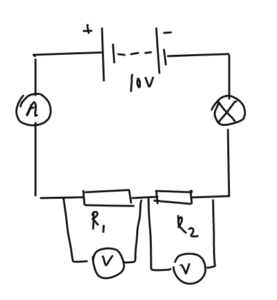
02.4 3.0 C (Coulombs) (Charge = Current * Time = 0.15*20)
02.5 30 J (Joules) ( Energy = Voltage * charge = 10V * 3 C)
03.1 the voltmeter is in series with
the coil of wire. In order to measure the potential difference the voltmeter should be connected in parallel
03.2 The water helps to maintain a constant temperature throughout. Therefore the coil of wire is in water.
03.3 The ammeter will give the reading of the voltage. The ammeter will give the reading of the current. The voltmeter reading will be divided by the current reading to give the value of resistance.
03.4 The student should work with lower voltages as the current is flowing in the water .
